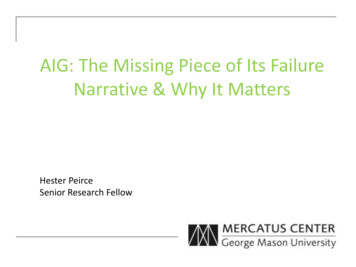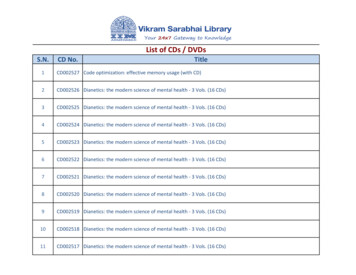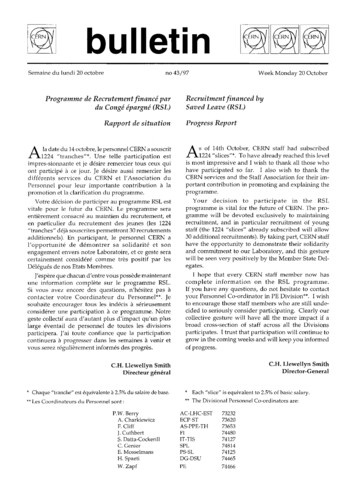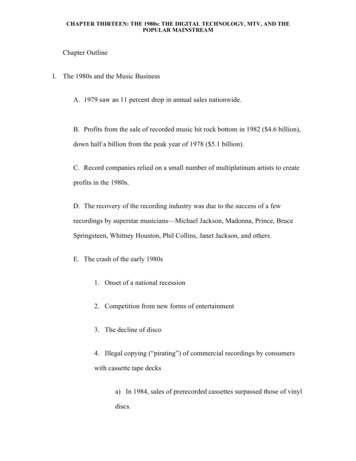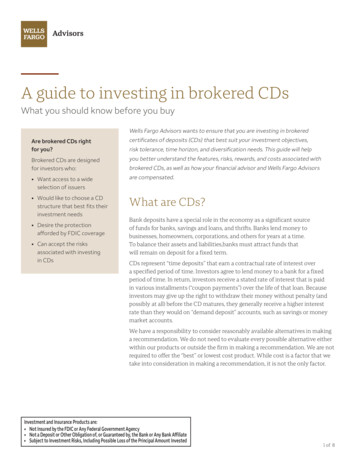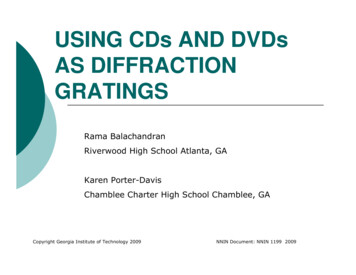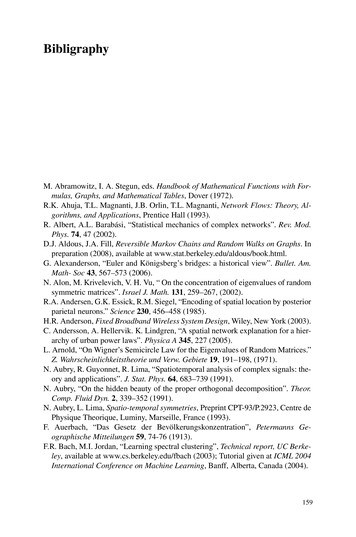
Transcription
BibligraphyM. Abramowitz, I. A. Stegun, eds. Handbook of Mathematical Functions with Formulas, Graphs, and Mathematical Tables, Dover (1972).R.K. Ahuja, T.L. Magnanti, J.B. Orlin, T.L. Magnanti, Network Flows: Theory, Algorithms, and Applications, Prentice Hall (1993).R. Albert, A.L. Barabási, “Statistical mechanics of complex networks”. Rev. Mod.Phys. 74, 47 (2002).D.J. Aldous, J.A. Fill, Reversible Markov Chains and Random Walks on Graphs. Inpreparation (2008), available at www.stat.berkeley.edu/aldous/book.html.G. Alexanderson, “Euler and Königsberg’s bridges: a historical view”. Bullet. Am.Math- Soc 43, 567–573 (2006).N. Alon, M. Krivelevich, V. H. Vu, “ On the concentration of eigenvalues of randomsymmetric matrices”. Israel J. Math. 131, 259–267, (2002).R.A. Andersen, G.K. Essick, R.M. Siegel, “Encoding of spatial location by posteriorparietal neurons.” Science 230, 456–458 (1985).H.R. Anderson, Fixed Broadband Wireless System Design, Wiley, New York (2003).C. Andersson, A. Hellervik. K. Lindgren, “A spatial network explanation for a hierarchy of urban power laws”. Physica A 345, 227 (2005).L. Arnold, “On Wigner’s Semicircle Law for the Eigenvalues of Random Matrices.”Z. Wahrscheinlichkeitstheorie und Verw. Gebiete 19, 191–198, (1971).N. Aubry, R. Guyonnet, R. Lima, “Spatiotemporal analysis of complex signals: theory and applications”. J. Stat. Phys. 64, 683–739 (1991).N. Aubry, “On the hidden beauty of the proper orthogonal decomposition”. Theor.Comp. Fluid Dyn. 2, 339–352 (1991).N. Aubry, L. Lima, Spatio-temporal symmetries, Preprint CPT-93/P.2923, Centre dePhysique Theorique, Luminy, Marseille, France (1993).F. Auerbach, “Das Gesetz der Bevölkerungskonzentration”, Petermanns Geographische Mitteilungen 59, 74-76 (1913).F.R. Bach, M.I. Jordan, “Learning spectral clustering”, Technical report, UC Berkeley, available at www.cs.berkeley.edu/fbach (2003); Tutorial given at ICML 2004International Conference on Machine Learning, Banff, Alberta, Canada (2004).159
160BibligraphyB.T. Backus, I. Oruç, “Illusory motion from change over time in the response tocontrast and luminance”. Jour. Vision, 5(11):10, 1055–1069, doi:10.1167/5.11.10(2005).J.P. Bagrow, E.M. Bollt, J.D. Skufca, D. ben-Avraham, “Portraits of complex networks”, Eur. Phys. Lett. 81, 68004 (6pp) (2008); doi:10.1209/02955075/81/68004.Y. Bao, G. Feng, T.-Y. Liu, Z.-M. Ma, Y. Wang, “Ranking websites: A probabilisticview”, Internet Math. 3 (3), 295–320 (2006).A.-L. Barabási, R. Albert, “Emergence of Scaling in Random Networks”. Science286, 509–512 (1999).A.-L. Barabàsi, Linked: How Everything is Connected to Everything Else, Penguin,(2004).A.-L. Barabási, “The origin of bursts and heavy tails in human dynamics.” Nature(London) 435, 207–211 (2005).M. Batty, P. Longley, Fractal Cities, Academic Press. London (1994).A. Beck, M. Bleicher, D. Crowe, Excursion into Mathematics, Worth Publishers(1969).F. Benford, “The law of anomalous numbers”, Proc. Am. Philos. Soc. 78, 551–572(1938).L.M.A. Bettencourt, J. Lobo, D. Helbing, C. Kühnert, G.B. West, “Growth, innovation, scaling, and the pace of life in cities”. PNAS 104 (17), 7301–7306 (2007);doi:10.1073/pnas.0610172104.J.M.H. Beusmans, “Computing the direction of heading from affine image flow”.Biol. Cybernetics 70, 123–136 (1993).K. Bharat, B.-W. Chang, M. Henzinger, M. Ruhl, “Who links to whom: Mininglinkage between web sites”. Proc. IEEE Int. Conf. Data Mining ICDM’01, SanJose, USA (2001).G. Bianconi, N. Gulbahce, A.E. Motter, Local structure of directed networks, Phys.Rev. Lett. 100, 118701 (2008).N. Biggs, Algebraic Graph Theory, Cambridge University Press (1974).N. Biggs, Permutation groups and combinatorial structures, Cambridge UniversityPress (1979).N. Biggs, E. Lloyd, R. Wilson, Graph Theory, 1736–1936. Oxford University Press(1986).S. Bilke, C. Peterson, “Topological properties of citation and metabolic networks”.Phys. Rev. E 64, 036106 (2001).T. Biyikoğlu, W. Hordijk, J. Leydold, T. Pisanski, P.F. Stadler, “Graph laplacians,nodal domains, and hyperplane arrangements”. Lin. Alg. Appl. 390, 155–174(2004).A. Björner, L. Lovász, P. Shor, “Chip-firing games on graphs.” Eur. J. Combin. 12,283–291 (1991).A. Björner, L. Lovász, “Chip-firing games on directed graphs.” J. Algebraic Comb.1, 305–328 (1992).Ph. Blanchard, T. Krüger, “The Cameo Principle and the origin of scale-free graphsin social networks”, J. Stat. Phys. 114 (5–6), 1399–1416 (2004).
Bibligraphy161Ph. Blanchard, M.-O. Hongler, “Modeling human activity in the spirit of Barabasi’squeueing systems”. Phys. Rev. E 75, 026102 (2007).Ph. Blanchard, D. Volchenkov, “Intelligibility and first passage times in complexurban networks”. Proc. R. Soc. A 464, 2153–2167 doi:10.1098/rspa.2007.0329(2008).I. Bloch, “On fuzzy distances and their use in image processing under imprecision”Pattern recognition 32 (11), 1873–1895, ISSN 0031-3203 CODEN PTNRA8(1999).S. Boccaletti, V. Latora, Y. Moreno, M. Chavez, D.-U. Hwang, “Complex networks:Structure and dynamics”. Phys. Rep. 424, 175 (2006).G. Bolch, S. Greiner, H. de Meer, K. S. Trivedi, Queueing Networks and MarkovChains: Modeling and Performance Evaluation with Computer Science Applications, John Wiley, second edition, New York, NY (2006).B. Bollobas, Graph Theory, Springer (1979).B. Bollobás, O. Riordan, “Mathematical results on scale-free random graphs”, inHandbook of Graphs and Networks, Wiley-VCH (2002).P.H.L. Bovy, E. Stern, Route Choice: Wayfinding in Transport Networks, KluwerAcademic Publishers, Dordrecht (1990).D. Braess, “Über ein Paradoxon aus der Verkehrsplannung”. Unternehmensforschung 12, 258–268 (1968).S. Brakman, H. Garretsen, C. van Marrewijk, M. van den Berg, J. Reg. Sci. 39,183–213 (1999).S. Brakman, H. Garretsen, C. van Marrewijk, An Introduction to Geographical Economics, Cambridge Univ. Press, Cambridge, New York (2001).A. Bretagnolle, E. Daudé, D. Pumain, “Cybergeo”, Revue Européene de Géographie335, 1 (2006).A. Brettel, The effects of “order” and “disorder” on human cognitive perception innavigating through urban environments. Thesis (Masters.MSc), UCL (UniversityCollege London) (2006).L. Breuer, D. Baum, An Introduction to Queueing Theory, Springer (2005).S. Brin, L. Page, R. Motwami, T. Winograd, “The pageRank citation ranking: Bringing order to the web”. Tech. Rep. 1999-0120, Computer Science Dept., StanfordUniversity, Stanford, CA (1999).N.J. Broadbent, L.R. Squire, R.E. Clark, “Spatial memory, recognition memory, andthe hippocampus”. PNAS 101 (40), 14515–14520 (2004).E. Brockmeyer, H.L. Halstrøm, A. Jensen, “The life and works of A.K. Erlang”.In Transactions of the Danish Academy of Technical Sciences 2. Available athttp://oldwww.com.dtu.dk/teletraffic/Erlang.html (1948).R. Brookhiser, “Urban Sundial - Manhattan’s grid system streets”, Nati. Rev., NY,July 9 (2001).M. Buchanan, Nexus: Small worlds and the Groundbreaking Theory of Networks.Norton, W. W. and Co., Inc. ISBN 0-393-32442-7 (2003).D. Burago, Yu.D. Burago, S. Ivanov, A Course in Metric Geometry, AMS (2001);ISBN 0-8218-2129-6.
162BibligraphyH. Busemann, P.J. Kelly, Projective Geometry and Projective Metrics, in Pure andApplied Mathematics 3 (eds.) P.A. Smith, S. Eilenberg, Academic Press Inc., Publishers (1953).S. Butler, Spectral graph theory, 3 lectures given at the Center for Combinatorics,Nankai University, Tianjin, September (2006).S. Butler, “Interlacing for weighted graphs using the normalized Laplacian”. Electronic J. Lin. Alg. 16, 90-98 (2007).A. Cardillo, S. Scellato, V. Latora, S. Porta, “Structural properties of planar graphsof urban street patterns”. Phys. Rev. E 73, 066107 (2006).R. Carvalho, A. Penn, “Scaling and universality in the micro-structure of urbanspace”. Physica A, 332, 539–547 (2004).M. Castells, The Internet Galaxy: Reflections on the Internet, Business, and Society,Oxford (2001).L.L. Cavalli-Sforza, Genes, Peoples, and Languages, North Point Press (2000).P. Chan, M. Schlag, J. Zien, IEEE Trans. CAD-Integrated Circuits and Systems 13,1088–1096 (1994).J. Cheeger, “A lower bound for the smallest eigenvalue of the Laplacian”, Problemsin Analysis, Papers dedicated to Salomon Bochner, Princeton University Press195–199 (1969).K. Cheng, “A purely geometric module in the rat’s spatial representation”. Cognition23, 149–178 (1986).M. Chown, “The future poverty hiding in cities”. New Scient 2628, 3 November2007.W. Christaller, Central Places in Southern Germany, Prentice Hall, EnglewoodCliffs, NJ (1966).F. Chung, “Diameters and eigenvalues”. J. Am. Math. Soc. 2, 187–196 (1989).F. Chung, R.L. Graham, R.M. Wilson, “Quasi-random graphs”. Combinatorica 9,345–362 (1989).F. Chung, Lecture notes on spectral graph theory, AMS Publications Providence(1997).F. Chung, L. Lu, V. Vu, “Spectra of random graphs with given expected degrees.”Proc. Natl. Acad. Sci. USA. 100(11): 6313–6318. (2003); Published online doi:10.1073/pnas.0937490100.F. Chung, “Laplacians and the Cheeger inequality for directed graphs,” Annals ofCombinatorics 9, 1–19 (2005).Churchill, Famous Quotations/Stories of Winston Churchill at http://www. winstonchurchill.org.J. Cohen, P. Cohen, S.G. West, L.S. Aiken, Applied Multiple Regression /Correlation Analysis for the Behavioral Sciences. (3rd ed.) Hillsdale, NJ: LawrenceErlbaum Associates (2003).D. Coppersmith, P. Tetali, P. Winkler. “Collisions among random walks on a graph”.SIAM J. Discrete Math. 6(3), 363-374 (1993).T.H. Cormen, C.E. Leiserson, R.L. Rivest, C. Stein. Introduction to Algorithms, Second Edition. MIT Press and McGraw-Hill, (2001). ISBN 0-262-03293-7. Chapter21: Data structures for Disjoint Sets, pp.498-524.
Bibligraphy163L. da F. Costa, G. Travieso, “Exploring complex networks through random walks”,Phys. Rev. E 75, 016102 (2007).T.M. Cover, J.A. Thomas, Elements of Information Theory. New York: Wiley,(1991).P. Crucitti, V. Latora, S. Porta, “Centrality in networks of urban streets”. Chaos 16,015113 (2006).C. R. Dalton, N.S. Dalton, “A spatial signature of sprawl: or the proportion anddistribution of linear network circuits”. In: GeoComputation 2005, 1–3 August2005, Ann Arbor, Michigan, USA (2005).C.R. Dalton, N.S. Dalton, “The theory of natural movement and its application to thesimulation of mobile ad hoc networks (MANET)”. In 5th Annual Conference onCommunication Networks and Services Research (CNSR2007), 14-17 May 2007,New Brunswick, Canada (2007).G.B. Dantzig, R. Fulkerson, S. M. Johnson, “Solution of a large-scale. travelingsalesman problem”. Operations Research, 2, 393–410 (1954).E.B. Davis, G.M.L. Gladwell, J. Leydold, P.F. Stadler, “Discrete nodal domain theorems”. Lin. Alg. Appl. 336, 51–60 (2001).R. Diestel, Graph Theory, Springer (2005).M. Deyer, A. Frieze, R. Kannan, “A random polynomial time algorithm for estimating volumes of convex bodies”, Proc. 21st Annual ACM Symposium on the theoryof Computing, 68–74 (1986).I. Dhillon, Y. Guan, B. Kulis, “A unified view of kernel k-means, spectral clustering and graph cuts”. Technical Report TR-04-25, University of Texas at Austin(2004).I. Dhillon, Y. Guan, B. Kulis, “Kernel k-means: spectral clustering and normalized cuts”, in Proceedings of the 10th ACM SIGKDD international conference onKnowledge discovery and data mining, Seattle, WA, USA (2004).P. Diaconis, Group Representations in Probability and Statistics, Inst. of Math.Statistics, Hayward, CA (1988).S. Dill, R. Kumar, K. McCurley, S. Rajagopalan, D. Sivakumar, A. Tomkins, “Selfsimilarity in the Web.” Proc. Int. Conf. Very Large Data Bases, 69–78 (2001).C. Ding, X. He, “K-means clustering via principal component analysis”. Proc. ofIntl. Conf. Machine Learning (ICML’2004), 225–232. July 2004.L. Donetti, F. Neri and M. A. Muñoz, “Optimal network topologies: Expanders,Cages, Ramanujan graphs, Entangled networks and all that.” J. Stat. Mech.,P08007 (2006), doi:10.1088/1742-5468/2006/08/P08007.S.N. Dorogovtsev, A.V. Goltsev, J.F.F. Mendes, A.N. Samukhin, “Renormalizationgroup for evolving networks.” Phys. Rev. E 68, 046109 (2003).C. Dunn, “Crime area research”. In: D. Georges, K. Harris, (eds.), Crime: A SpatialPerspective, NY, Columbia Press (1980).E. Durkheim, The Division of Labor in Society, Free Press, (1964).M. Ebihara, H. Mahara, T. Sakurai, A. Nomura, H. Miike, “Image Processing bya Discrete Reaction-diffusion System”, from Proc. Visualization, Imaging, andImage Processing (2003).
164BibligraphyEEA, European Environment Agency report Urban sprawl in Europe. The ignoredchallenge, ISBN 92-9167-887-2 (2006).M.Egenhofer, D.M. Mark, Naive Geography In: A.U. Frank, W. Kuhn (eds.) SpatialInformation Theory: A Theoretical Basis for GIS, Springer, (1995).G.B. West, J.H. Brown, B.J. Enquist, “A general model for the origin of allometricscaling laws in biology.” Nature 395, 163–166 (1998).P. Erdös, A. Renyi, “On random graphs” Publ. Math. Debrecen 6, 290 (1959).K.A. Eriksen, I. Simonsen, S. Maslov, K. Sneppen, “Modularity and extreme edgesof the interet”. Phys. Rev. Lett. 90 (14), 148701 (2003).EU Environment 2006 “Improving the quality of life in urban areas - Investments inawareness raising and environmental technologies”. The Discussion paper for theInformal Meeting of EU Environment Ministers, 19–20 May 2006 Eisenstat/Rust.Austria.A. Fabrikant, E. Koutsoupias, C.H. Papadimitriou. Heuristically optimized tradeoffs: A new paradigm for power laws in the internet. ICALP (2002).C. Faloutsos, M. Faloutsos, P. Faloutsos, On power-law relationships of the internettopology, in Proc. CIGCOMM (1999).K. Fan, “On a theorem of Weyl concerning eigenvalues of linear transformations.”Proc. Natl. Acad. Sci. USA 35, 652–655 (1949).I.J. Farkas, I. Derényi, A.-L. Barabási, T. Vicsek, “Spectra of “Real-World” graphs:Beyond the semi-circle law.” Phys. Rev. E 64, 026704 (2001).I. Farkas, I. Derényi, H. Jeong, Z. Neda, Z.N. Oltvai, E. Ravasz, A. Schubert, A.-L.Barabási, T. Vicsek, “Networks in life: Scaling properties and eigenvalue spectra”. Physica A 314, 25 (2002).O. Faugeras, “Stratification of three-dimensional vision: projective, affine, and metric representations”. J. Opt. Soc. Am. A 12(3), 465–484 (1995).M. Fiedler, Algebraic connectivity of graphs.” Czech. Math. J. 23, 298 (1973); 25,146 (1975).L. Figueiredo, L. Amorim, Continuity lines in the axial system, in A. Van Nes (ed.):5th International Space Syntax Symposium, TU Delft, Faculty of Architecture,Section of Urban Renewal and Management, Delft, pp. 161–174 (2005).L. Figueiredo, L. Amorim, Decoding the urban grid: or why cities are neither treesnor perfect grids, 6th International Space Syntax Symposium, 12–15 Jun 2007,Istanbul, Turkey.M. Fisher, “Urban ecology”. Permaculture Design course handout notes availableat www.sel f willed land.org.uk (2008).M. Flanders, S. Helms Tillery, J.F. Soechting, “Early stages in a sensorimotor transformation”, Behavioral and Brain Sciences 15, 309–362 (1992).R. Florida, Cities and the Creative Class, Routledge, New York (2004).M. Frigo, C.E. Leiserson, H. Prokop, “Cache-oblivious algorithms”, in 40th Annual Symposium on Foundations of Computer Science, FOCS ’99, New York,NY, USA. IEEE Computer Society (1999).K. Fukunaga, Introduction to Statistical Pattern Recognition, ISBN 0122698517,Elsevier (1990).
Bibligraphy165S. Funahashi, C.J. Bruce, P.S. Goldman-Rakic, “Mnemonic coding of visual spacein the monkey’s dorsolateral prefrontal cortex.” J. Neuropysiol. 61, 331–349(1989).M. Fyhn, T. Hafting, A. Treves, M.-B. Moser, E.I. Moser, “Hippocampal remappingand grid realignment in entorhinal cortex.” Nature 446, 190–194 (2007).X. Gabaix, “Zipf’s Law for Cities: An Explanation,” Quart. J. Econ., 113 (3), 739–767 (1999).X. Gabaix, Y.M. Ioannides, “The evolution of city size distributions,” in: J.V. Henderson, J.F. Thisse (ed.), Handbook of Regional and Urban Economics, (ed. 1,vol. 4), ch. 53, 2341–2378 Elsevier (2004).GEO-4: environment for development. United Nations Environment Program,ISBN: 978-92-807-2836-1 (UNEP paperback) DEW/0962/NA, Progress PressLtd, Malta (2007).M. Girvan, M.E.J. Newman, “Community structure in social and biological networks”. PNAS 7821–7826 (2002).C. Godsil, G. Royle, Algebraic graph theory. New York Springer-Verlag (2004).ISBN 0-387-95241-1.R.G. Golledge, Wayfinding Behavior: Cognitive Mapping and Other Spatial Processes, John Hopkins University Press, ISBN: 0-8018-5993-X (1999).G. Golub, C. van Loan,Matrix computations, 3rd edition, The Johns Hopkins University Press, London (1996).J. Gomez-Gardenes, V. Latora, “Entropy rate of diffusion processes on complexnetworks”. E-print arXiv:0712.0278v1 [cond-mat.stat-mech] (2007); also in V.Latora, Proceedings of the Workshop Net-Works 2008, Pamplona, 9–11 June,(2008).A. Graham, Nonnegative Matrices and Applicable Topics in Linear Algebra, JohnWiley and Sons, New York (1987).J.H. Greene, Production and Inventory Control Handbook, 3rd edn. McGraw-Hill,New York (1997).N.M. Grzywacz, A.L. Yuille, “Theories for the visual perception of local velocity and coherent motion”. In M.S. Landy, J.A. Movshon (Eds.), Computationalmodels of visual processing, pp. 231–252, Cambridge, Massachusetts: MIT Press(1991).M. Haffner, M. Elsinga, Urban renewal performance in complex networks Casestudies in Amsterdam North and Rotterdam South, W16 – Institutional and Organizational Change in Social Housing Organization in Europe, Int. Conference onSustainable Urban Areas, Rotterdam (2007).T. Hafting, M. Fyhn, S. Molden, M.-B. Moser, E.I. Moser, “Microstructure of aspatial map in the entorhinal cortex.” Nature 436, 801–806 (2005).P. Haggett, R. Chorley (eds.), Socio-Economic Models in Geography, London,Methuen (1967).P. Haggett, R. Chorley, Network Analysis in Geography, Edward Arnold, London(1969).F.A. Haight, Handbook of the Poisson Distribution, Wiley, New York (1967).
166BibligraphyJ.M. Hanson, Order and Structure in Urban Space: A Morphological History ofLondon, Ph.D. Thesis, University College London (1989).G. Hatfield, “Representation and constraints: the inverse problem and the structureof visual space”, Acta Psychologica 114: 355–378 (2003).A. Held, “Die Bielefeld-Verschwörung”, available at http://www. bielefeldverschwoerung.de (in German) (1994).J. Henderson, “Economic Theory and the Cities.” Amer. Econ, Rev. LXIV, 640(1974).M.R. Henzinger, R. Motwani, C. Silverstein, “Challenges in Web Search Engines”,Proc. of the 18th Int. Joint Conf. on Artificial intelligence, 1573–1579 (2003).L. Hermer, E.S. Spelke, “A geometric process for spatial reorientation in youngchildren.” Nature 370, 57–59 (1994).R.C. Hill, C.F. Sirmans, J.R. Knight, Reg. Sci. Urban Econ. 29 (1), 89–103 (1999).B. Hillier, J. Hanson, The Social Logic of Space (1993, reprint, paperback editioned.). Cambridge: Cambridge University Press (1984).B. Hillier, R. Burdett, J. Peponis, A. Penn, “Creating life: or, does architecture determine anything?”Architecture and Comportment / Architecture and Behavior 3(3),233–250 (1987).B. Hillier, Space is the machine. A configurational theory of architecture, Cambridge University Press, (1996, 1999).B. Hillier, “A theory of the city as object: or, how spatial laws mediate the socialconstruction of urban space”, Urban Des. Int., 7, pp. 153–179 (2002).B. Hillier, The common language of space: a way of looking at the social, economicand environmental functioning of cities on a common basis, Bartlett School ofGraduate Studies, London (2004).B. Hillier, “The art of place and the science of space”, World Architecture 11/2005(185), Beijing, Special Issue on Space Syntax pp. 24–34 (in Chinese), pp. 96–102(in English) (2005).B. Hillier, From Object- to Space-based Models of the City. Some new phenomena in the passage from model to theory, Workshop: Evolution and Structureof Complex Systems and Networks, Zentrum fuer Interdisciplinaere Forschung,Bielefeld, February 25–29, 2008 (Germany).R.A. Horn and C.R. Johnson, Matrix Analysis, Cambridge University Press, 1990(Chap. 8).B.D. Hughes, Random Walks and Random Environments, Oxford Univ. Press.(1996).S. Iida, B. Hillier, “Network and psychological effects in urban movement”, in A.G.Cohn, D.M. Mark (eds) Proc. of Int. Conf. in Spatial Information Theory: COSIT2005 published in Lecture Notes in Computer Science 3693, 475–490, SpringerVerlag (2005).Y. Ihara, “On discrete subgroups of the two by two projective linear group overp-adic fields”, J. Math. Soc. Japan 18, 219–235 (1966).B. Jabbari, Zh. Yong, F. Hillier, “Simple random walk models for wireless terminalmovements”, Vehicular Technology Conf., 1999 IEEE 49th 3, 1784–1788 (Jul1999).
Bibligraphy167M.R. Jerrum, A. Sinclair, “Approximating the Permanent”. SIAM J. Comput. 18 (6)1149–1178 (1989).B. Jiang, “A space syntax approach to spatial cognition in urban environments”,Position paper for NSF-funded research workshop Cognitive Models of DynamicPhenomena and Their Representations, October 29–31, 1998, University of Pittsburgh, Pittsburgh, PA (1998).B. Jiang, Ch. Claramunt, and B. Klarqvist, “An integration of space syntax into GISfor modeling urban spaces”, , International Journal of Applied Earth Observations and Geoinformation, International Institute for Aerospace Survey and earthSciences (ITC), Enschede, The Netherlands, 2(3/4), pp. 161–171, Vol. 2 (3/4),161–171 (2000).B. Jiang, C. Claramunt, “Topological analysis of urban street networks”. Environ.Plan. B: Plan. Des. 31, 151–162 (2004).I.T. Jolliffe, Principal Component Analysis (2-nd edition) Springer Series in Statistics (2002).W.-S. Jung, F. Wang, H.E. Stanley, “Gravity model in the Korean highway”, Europhys. Lett. (EPL) 81, 48005 (6pp) doi:10.1209/0295-5075/81/48005 (2008).M. Kac, “On the Notion of Recurrence in Discrete Stochastic Processes”, Bulletinof the American Mathematical Society 53, pp. 1002–1010 (1947) [Reprinted inKac’s Probability, Number Theory, and Statistical Physics: Selected Papers, pp.231–239]K.J. Kansky, Structure of Transportation Networks: Relationships Between NetworkGeometry and Regional Characteristics, Research Paper 84, Department of Geography, University of Chicago , Chicago, IL (1963).K. Karhunen, “Zur Spektraltheorie stochatischer Prozesse”. Ann. Acad. Sci. Fennicae A:1 (1944).K. Karimi, “The spatial logic of organic cities in Iran and in the United Kingdom” inProc. 1st International Space Syntax Symposium, M. Major, L. Amorim, F. Dufaux (eds), University College London, London, vol. 1, 05.1–05.17 (1997).R. Karp, “Reducibility Among Combinatorial Problems”. Proc. Symp. on the Complexity of Computer Computations, Plenum Press (1972).R.W. Kates, T.M. Parris, “Long-term trends and a sustainability transition”. Proc.Natl. Acad. Sci. USA 100:8062–8067 (2003).S. M. Keane, Stock Market Efficiency, Oxford: Philip Allan Ltd. (1983).S.H. Kellert, “Space perception and the fourth dimension”, Man and World 27: 161180, Springer Netherlands (1994).H. Kimon, Religion and New Immigrants: A Grantmaking Strategy at The PewCharitable Trusts. Religion Program, the Pew Charitable Trusts (2001).B. Klarqvist, 1993 A Space Syntax Glossary, Nordisk Arkitekturforskning 2.J. Kleinberg, “Authoritative sources in a hyperlinked environment”. J. ACM 46,604–632 (1999).J.J. Koenderink, A.J. van Doorn. “Affine structure from motion”. J. Opt. Soc. Am. A8, 377–385 (1991).G. Kolata, “What if they closed the 42nd Street and nobody noticed?”, The NewYork Times, Dec. 25 (1990).
168BibligraphyR.I. Kondor, J. Lafferty, “Diffusion kernels on graphs and other discrete structures”.In C. Sammut and A. G. Hoffmann, editors, Machine Learning, Proceedings ofthe 19th International Conference (ICML 2002), pages 315–322. San Francisco,Morgan Kaufmann, (2002).B.O. Koopman, “Hamiltonian Systems and Transformations in Hilbert Space”.Proc. Natl. Acad. Sci. USA 17 315–318 (1931).M.J.T. Kruger, On node and axial grid maps: distance measures and related topics.Other. Bartlett School of Architecture and Planning, UCL, London, UK (1989).M. Lackenby, “Heegaard splittings, the virtually Haken conjecture and Property(tau).” Invent. Math. 164, 317-359 (2006).J.-L. Lagrange, Œuvres, 1, 72–79, Gauthier-Villars (1867) (in French). This remarkhas been given in deVerdiere 1998, p.5.H. Ling, K. Okada “Diffusion Distance for Histogram Comparison”, Proc. IEEEComp. Soc. Conf. Computer Vision and Pattern Recognition (2006).N. Linial, A. Wigderson, Course 67659 Expander graphs and their applications,Lecture notes available on-line on the web-page of the institute of AdvancedStudies, Princeton, New Jersey (2005); also in N. Linial, Discrete Mathematics:Expanders Graphs and Eigenvalues, Research Channel, Video Library producedby: University of Washington (2005).A. Lösch, The Economics of Location, Yale University Press, New Haven (1954).M. Loève, Probability Theory, van Nostrand, New York (1955).L. Lovász, 1993 Random Walks On Graphs: A Survey. Bolyai Society MathematicalStudies 2: Combinatorics, Paul Erdös is Eighty, Keszthely (Hungary), p. 1–46.L. Lovász, P. Winkler, Mixing of Random Walks and Other Diffusions on a Graph.Surveys in combinatorics, Stirling, pp. 119–154, London Math. Soc. Lecture NoteSer. 218, Cambridge Univ. Press (1995).S. Low, L. Zuniga (eds.), The Anthropology of Space and Place: Locating Culture,Blackwell Publishing (2003).B. Lucas, Which side of the road do they drive on? http://www. brianlucas.ca/roadside/ (2005).Q.-T. Luong, T. Viéville, “Canonic representations for the geometries of multipleprojective views”. In Proceedings of the 3rd European Conference on ComputerVision, J.-O. Eklundh (ed.) Vol. 800/801 of Lecture Notes in Computer Science,1, 589–599, Springer-Verlag, Berlin (1994).U. von Luzburg, M. Belkin. O. Bousquet, “Consistency of Spectral Clustering”,Technical Report N. TR-134, Max-Planck-Institut fuer biologische Kybernetik(2004).K. Lynch, The Image of the City, The M.I.T. and Harvard University Press, Cambridge, Mass (1960).Sh.-K. Ma, Statistical mechanics, World Scientific (1985).M.C. Mackey, Time’s Arrow: The Origins of Thermodynamic Behavior, Springer(1991).M. Major, “Are American cities different? if so, how do they differ” in Proc. 1st International Space Syntax Symposium (1997). In: M. Major, L. Amorim, F. Dufaux(eds), University College London, London, 3, 09.1–09.14 (1997).
Bibligraphy169H.A. Makse, A. Halvin., H.E. Stanley, “Modeling urban growth pattern”. Nature377, 608–612 (1995).J. Margules, C.R. Gallistel, “Heading in the rat: Determination by environmentalshape.” Anim. Learn. Behav. 16, 404–410 (1988).A.A. Markov, Extension of the limit theorems of probability theory to a sum of variables connected in a chain, reprinted in Appendix B of: R. Howard. DynamicProbabilistic Systems, 1: Markov Chains, John Wiley and Sons (1971).L.E. Mays, D.L. Sparks, “Dissociation of visual and saccade-related responses insuperior colliculus neurons”. Science 230, 1163–1165 (1980).B.L. McNaughton, F.P. Battaglia, O. Jensen, E.I. Moser, M.-B. Moser, “Path integration and the neural basis of the cognitive map”. Nature Rev. Neurosci. 7, 663–678(2006).V. Medeiros, F. Holanda, “Urbis Brasiliae: investigating topological and geometricalfeatures in Brazilian cities”. In: A. Van Nes (ed.), Proc. 5th International SpaceSyntax Symposium, Delft, Faculty of Architecture, Section of Urban Renewal andManagement, pp. 331–339 (2005).M. Merleau - Ponty, The Phenomenology of Perception, trans. C. Smith. London:Routledge & Kegan Paul (1962).R.K. Merton, “The Matthew effect in science.” Science 159, 56–63 (1968).J.G. Miller, Living Systems, McGraw-Hill, New York (1978).H. Minc, Nonnegative matrices, John Wiley and Sons, New York, ISBN 0-47183966-3 (1988).A. Möbius, Der barycentrische Calcul, Hildesheim, Germany (1827).J. Morris, Venice, 3rd revised edition, Faber & Faber (1993).T. Morris, Computer Vision and Image Processing. Palgrave Macmillan. ISBN0-333-99451-5 (2004).B. Nadler, S. Lafon, R.R. Coifman and I.G. Kevrekidis, “Diffusion maps, spectral clustering and reaction coordinate of dynamical systems”, Applied and Computational Harmonic Analysis: Special issue on Diffusion Maps and Wavelets,21,113–127 (2006).J. Nesetril, E. Milková, H. Nesetrilová, Otakar Boruvka on Minimum SpanningTree Problem (translation of the both 1926 papers, comments, history), CiteSeer,DMATH: Discrete Mathematics (2000).S. Newcomb, “Note on the frequency of use of the different digits in natural numbers”, Am. J. Math. 4, 39–40 (1881).M.E.J. Newman, “The Structure and Function of Complex Networks.” SIAM Revi.45, 167–256 (2003).J. Norman, H. L. MacLean, and Ch. A. Kennedy, “Comparing High and Low Residential Density: Life-Cycle Analysis of Energy Use and Greenhouse Gas Emissions.” J. Urban Plan. Dev. 132(1), 10–21 (2006).J.F. Normann, J.T. Todd, “The perceptual analysis of structure from motion for rotating objects undergoing affine stretching transformations”, Percept. Psychophys.53, 279–291 (1993).J. O’Keefe, “Place units in the hippocampus of the freely moving rat.” J. Exp. Neurol. 51, 78–109 (1976).
170BibligraphyJ. O’Keefe, L. Nadel, The Hippocampus as a Cognitive Map, Clarendon, Oxford(1978).J. O’Keefe, “Cognitive maps in infants?” Nature 370, 19-20 (1994).S. Orford, D. Dorling, R. Mitchell, M. Shaw & G. Davey-Smith, “Life and deathof the people of London a historical GIS of Charles Booth’s inquiry.” Health andPlace 8 (1), 25–35 (2002).P. Ortega-Andeane, E. Jiménez-Rosas, S. Mercado-Doménech, and C. EstradaRodrýguez, “Space syntax as a determinant of spatial orientation perception.”Int. J. of Psychol, 40 (1), 11–18 (2005).E. Parzen, “On estimation of a probability density function and mode”. Ann. Math.Stat. 33, 1065–1076 (1962).M. Pica Ciamarra, A. Coniglioa, “Random walk, cluster growth, and the morphology of urban conglomerations”. Physica A 363 (2), 551–557 (2006).L. Pietronero, E. Tosatti, V. Tosatti, A. Vespignani, “Explaining the uneven distribution of numbers in nature: the laws of Benford and Zipf”. Physica A 293, 297–304(2001).F.E. Pollick, G. Sapiro, “Constant Affine Velocity Predicts th
Bibligraphy 161 Ph. Blanchard, M.-O. Hongler, "Modeling human activity in the spirit of Barabasi's queueing systems". Phys. Rev. E 75, 026102 (2007). Ph. Blanchard, D. Volchenkov, "Intelligibility and first passage times in complex



